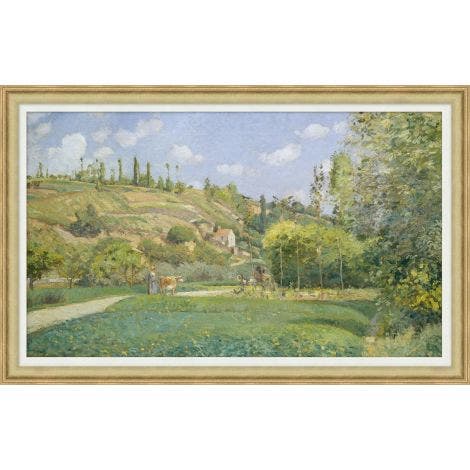Local Storage seems to be disabled in your browser.
For the best experience on our site, be sure to turn on Local Storage in your browser.
A Cowherd at Valhermeil, Auvers-sur-Oise

This Met x Wendover Art Group design is a reproduction of an original work of art in The Metropolitan Museum of Art collection.
Our inspiration: A Cowherd at Valhermeil, Auvers-sur-Oise
Camille Pissarro (French, 1830–1903)
Oil on canvas, 21 5/8 x 36 1/4 in., 1874
Gift of Edna H. Sachs, 1956 56.182
This view shows one of the roads connecting the hamlet of Valhermeil in Auvers with Pontoise, the village northwest of Paris where Pissarro lived for many years. Between 1873 and 1882, he painted some 20 works in this area, several featuring the same red-roofed house. Villagers walking on paths through the French countryside was one of the artist’s favorite subjects, reflecting his interest in the pulse of daily rural life. Made in 1874, the year of the first Impressionist exhibition, this picture demonstrates Pissarro’s adaptation of the looser touch, broken brushstrokes, and lighter palette of younger colleagues such
as Claude Monet.

This Met x Wendover Art Group design is a reproduction of an original work of art in The Metropolitan Museum of Art collection.
Our inspiration: A Cowherd at Valhermeil, Auvers-sur-Oise
Camille Pissarro (French, 1830–1903)
Oil on canvas, 21 5/8 x 36 1/4 in., 1874
Gift of Edna H. Sachs, 1956 56.182
This view shows one of the roads connecting the hamlet of Valhermeil in Auvers with Pontoise, the village northwest of Paris where Pissarro lived for many years. Between 1873 and 1882, he painted some 20 works in this area, several featuring the same red-roofed house. Villagers walking on paths through the French countryside was one of the artist’s favorite subjects, reflecting his interest in the pulse of daily rural life. Made in 1874, the year of the first Impressionist exhibition, this picture demonstrates Pissarro’s adaptation of the looser touch, broken brushstrokes, and lighter palette of younger colleagues such
as Claude Monet.



